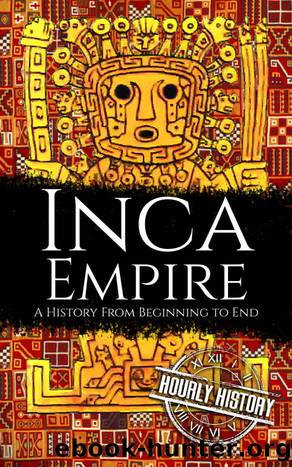Inca Empire: A History from Beginning to End by Hourly History

Author:Hourly History [History, Hourly]
Language: eng
Format: epub
Published: 2020-05-17T00:00:00+00:00
Chapter Five
Life in the Inca Empire
âThe Incasâ geniusâ like that of the Romansâlay in their masterful organizational abilities. Amazingly, an ethnic group that probably never exceeded 100,000 individuals was able to regulate the activities of roughly ten million people.â
âKim MacQuarrie, The Last Days of the Incas
The government of the Inca Empire was autocratic and controlling in the extreme. Even the clothing which its citizens wore was defined and supplied by the state. Each Inca was provided with two sets of clothesâa tunic for everyday use, made from Awaska cloth woven from llama wool and another made from finer cloth, qunpi, often woven from alpaca wool, for formal or ceremonial occasions. These were worn until they were reduced to rags as no Inca was permitted to change or replace their clothing without permission. These tunics incorporated a geometric design which indicated the status of the wearerâfor example, members of the army wore tunics decorated with a black and white checkered pattern.
People of special importance also wore a turban-like hat which incorporated designs and colors which denoted the family to which they belonged. These llawt'u also denoted the social standing of the wearerâthe finer the cloth and more intricate the design, the wealthier the individual. In order to stress his importance, one Sapa Inca had a llawt'u made entirely from hair taken from vampire bats.
The designs which decorated clothes were also used on ceramics, wood carvings, and metalwork. Like every other aspect of Inca life, these designs were standardized and set by the state. Inca designs generally incorporated simple geometrical shapes, sometimes enlivened by simplified representations of animals. These formed an instantly recognizable imperial design which was replicated throughout the empire.
The government itself was headed by the Sapa Inca who was responsible for making all important decisions. He was assisted by a council comprising representatives from ten important Inca families. These panaqa were also involved in ratifying the Sapa Incaâs choice of his successor. Next in importance to the panaqa were the representatives of ten more groups taken from slightly less influential families (or from families with a less direct blood connection to the Sapa Inca). Then there were representatives of noble families who were not Incas, but whose assimilation into the Inca Empire made them important. There was no formal system of government or advising, and there was often great rivalry between these various group of nobles for the attention of the Sapa Inca.
Each of the four quarters of the empire was administered by a regional governor who had under his control up to 80 local administrators, generally ethnic Incas. Below these Incas were kurakas, nobles from the local area who were often not themselves ethnic Incas. One of the functions of local administrators was the taking of a regular census on which the level of tribute was based. This was overseen and checked by an inspector appointed by the regional governor, the tokoyrikoq (âhe who sees allâ). These records were not kept in writing (the Incas had no written language)
Download
This site does not store any files on its server. We only index and link to content provided by other sites. Please contact the content providers to delete copyright contents if any and email us, we'll remove relevant links or contents immediately.
| Africa | Americas |
| Arctic & Antarctica | Asia |
| Australia & Oceania | Europe |
| Middle East | Russia |
| United States | World |
| Ancient Civilizations | Military |
| Historical Study & Educational Resources |
Magic and Divination in Early Islam by Emilie Savage-Smith;(1462)
Ambition and Desire: The Dangerous Life of Josephine Bonaparte by Kate Williams(1286)
Bohemians, Bootleggers, Flappers, and Swells: The Best of Early Vanity Fair by Bohemians Bootleggers Flappers & Swells- The Best of Early Vanity Fair (epub)(1264)
Papillon by Henry Charrière(1263)
Twelve Caesars by Mary Beard(1146)
Operation Vengeance: The Astonishing Aerial Ambush That Changed World War II by Dan Hampton(1113)
What Really Happened: The Death of Hitler by Robert J. Hutchinson(1075)
London in the Twentieth Century by Jerry White(1054)
Time of the Magicians by Wolfram Eilenberger(1030)
Twilight of the Gods by Ian W. Toll(1026)
The Japanese by Christopher Harding(1025)
Lenin: A Biography by Robert Service(986)
The Devil You Know by Charles M. Blow(935)
Freemasons for Dummies by Hodapp Christopher;(891)
A Social History of the Media by Peter Burke & Peter Burke(885)
Napolean Hill Collection by Napoleon Hill(861)
The Churchill Complex by Ian Buruma(859)
The Rise and Triumph of the Modern Self by Unknown(855)
Henry III by David Carpenter;(854)
